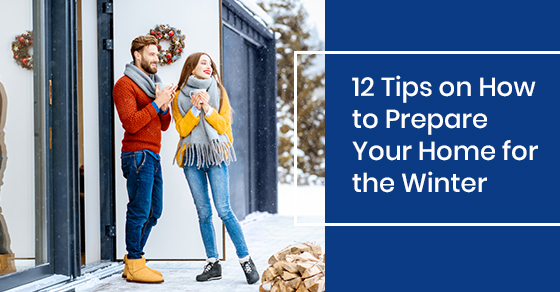
12 Tips on How to Prepare Your Home for the Winter
Posted by on Dec 02, 2019 in
Homeownership comes with a lot of responsibility. Not only do you want to take pride in your home, but also ensure you are maintaining it to avoid costly damage down the road. Being aware of any seasonal maintenance your house requires can help you keep on top of the little jobs to keep your home humming. Besides, it helps keep your energy bills down while reducing the risk of severe damage that will affect your home insurance rates. When fall arrives, 12 things will need your attention. Here we outline what’s involved so you can add them to your to-do list or plan accordingly by hiring a professional to help you out.
1. Heating system repairs
Call your local heating expert to have them come in and do a heating system tune-up. You can also arrange a maintenance schedule so that they call you in the spring and fall to provide maintenance for your HVAC system. The technician will first inspect your furnace to see if repairs are required. They will clean your heater and do some basic maintenance so it is in working order. An important check includes leaks for carbon-monoxide to keep your family safe when your heater is operating. With regular maintenance, you will avoid costly repairs in the future and help keep your heater functioning with minimal energy waste.2. Adjust ceiling fans
Not everyone has ceiling fans, but if you do, you probably only use them in the summer. But did you know that you can also use them to improve heat efficiency in your home during winter as well? Reversing your ceiling fan will make it run clockwise, producing an updraft. This will force hot air back down as it rises to the ceiling, keeping your rooms warm. The higher your ceilings, the more effective running your ceiling fan in reverse becomes. You might find you can turn your thermostat down as heating efficiency improves.3. Clean eavestroughs and gutters
The summer can leave debris in your eavestroughs and gutters, leading to several issues once winter arrives. First, debris can cause ice dams when the water has nowhere to go. The clogged gutters force water back up into your roof, which leads to leaks and expensive water damage. Remember, home insurance companies can deny claims if they feel damage occurred due to long-term leaks that were not fixed. Full gutters can also cause issues with siding and wood trim. If you’re not comfortable climbing a ladder, you can get a professional to come in and do the work for you.4. Fix attic and roof issues
Your attic can be the source of air leaks that affect your home’s energy efficiency. In the winter months, heat can escape through the roof if your attic is not insulated correctly. When heat escapes, it melts the snow on the roof, which can lead to leaks and issues such as ice dams, as mentioned. These can lead to costly damage, which can increase your home insurance rates if you file a claim. Air leaks can also occur in the attic. You can take a look for yourself or consider having a qualified roof inspector take a look.5. Roof maintenance
The unpredictable weather of the summer can lead to issues with your roof, such as missing shingles that can increase the risk of leaks. As suggested above, a roof inspection is an excellent way to keep your roof in tip-top condition. A roof inspector will climb up and look for any issues with your roof. They will also check your attic for signs of leaks. A walk around your home will identify other potential problems with other roof elements, including your eavestroughs and fascia.6. Seal air leaks
Caulking is used for sealing air leaks in cracks, gaps or joints. You can use it to seal areas around door jambs, window frames and other areas that might have leaks. Areas to check include:- Electrical outlets
- Switch-plates
- Door and window frames
- Electrical and gas service entrances
- Baseboards
- Fireplace dampers
- Attic hatches
- Cable TV and phone lines
- Dryer vents
- Vents and fans
- Wall- or window-mounted air conditioners
- Recessed lighting
7. Divert water
Your downspouts should be leading water away from your home’s foundation. You can add extensions to keep the water about a meter away from your foundation to avoid damage.8. Manage exterior faucets
A rookie mistake for new homeowners is to forget to turn off exterior faucets. If water remains in exterior pipes, it will freeze when temperatures drop. Pipes can burst, leading to unexpected flooding. If this happens, your home insurance company might not cover damages as you will be at fault. To avoid this issue, follow these steps:- Disconnect garden hoses
- Drain water in faucets
- Turn off the shut-off valve inside your home
9. Drain lawn-irrigation systems
It would be best if you drained your sprinkler-system pipes to avoid freezing, which can also lead to bursts and leaks. Follow these steps:- Close the main valve to turn off the water supply to drain the water.
- Open the drain cap between the main valve and backflow device to remove trapped water.
- Drain residual water from sprinkler heads by gently lifting them.

